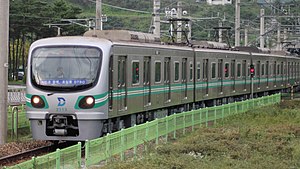Daegu Metro
 Daegu Metro Line 2 | |||
| Overview | |||
|---|---|---|---|
| Owner | City of Daegu | ||
| Locale | Daegu, South Korea | ||
| Transit type | Rapid transit and Monorail | ||
| Number of lines | 2 rapid transit 1 monorail | ||
| Number of stations | 60 (rapid transit only)[1] 90 (incl. monorail) | ||
| Operation | |||
| Began operation | 26 November 1997 | ||
| Operator(s) | Daegu Metropolitan Transit Corporation | ||
| Number of vehicles | Rapid transit train and monorail | ||
| Technical | |||
| System length | 59.8 km (37.2 mi) (rapid transit only)[1] 83.7 km (52.0 mi) (incl. monorail) | ||
| Track gauge | 1,435 mm (4 ft 8+1⁄2 in) (rapid transit only) | ||
| |||
| Daegu Metro | |
| Hangul | |
|---|---|
| Hanja | |
| Revised Romanization | Daegu dosicheoldo |
| McCune–Reischauer | Taegu tosich'ŏlto |

Daegu Metro (Korean: 대구도시철도; Hanja: 大邱都市鐵道; RR: Daegu dosicheoldo) is a metro system that serves primarily the South Korean city of Daegu.
On 28 April 1995, a gas explosion occurred at Line 1, a construction site located in Sangin-dong, Taegu. At least 101 people, including 42 students, were killed with as many as 202 people injured.[2]
Daegu subway fire broke out on 18 February 2003, when an arsonist set fire to a train in rush hour and killed nearly 200 people. Public safety in mass transit became a concern of Korean society.[3]
In December 2008, the Daegu Safety Theme Park opened. The goal is to educate the inhabitants of Daegu about safety in metro.[4]
Lines[]
| Line Name English |
Line Name Hangul |
Starting Station(s) | Ending Station(s) | Stations | Total Length |
|---|---|---|---|---|---|
| Rapid transit: | |||||
| 1호선 | Seolhwa-Myeonggok | Ansim | 32[1] | 28.4 km[1] | |
| 2호선 | Munyang | Yeungnam Univ. | 29[1] | 31.4 km[1] | |
| Monorail: | |||||
| 3호선 | KNU Medical Center | Yongji | 30 | 23.9 km | |
Line 1[]
Line 1 was completed in November 1997.
Line 2[]
Line 2 was completed in October 2005.
Line 3[]
Line 3, which is a monorail (unlike Lines 1 and 2), was completed and opened in April 2015.
Lines under construction[]
AGT line[]
The transport department has approved plans to build an Automated Guideway Transit line. The Color Of AGT line is Purple.
Fare[]
The fare is 1,400 won for a token to any stop on the subway and only 1,250 won with the use of a transportation card.
Rolling stock[]
Daegu Metro lines are segregated, each with its own distinct vehicles. Lines 1 and 2 use the same railway technology (rapid transit), while Line 3 uses an entirely different system (monorail).
| Line | Manufacturer (country of origin) | Model | Type | No. car sets ( No. of cars) |
|---|---|---|---|---|
| Line 1 | Hanjin Heavy Industries (Hanjin Transportation) ( |
1000-series | metro cars | 63 (216) |
| Line 2 | Hyundai Rotem ( |
2000-series | metro cars | 30 (180) |
| Line 3 | Hitachi Transportation Systems Korea ( Woojin Industrial System Company Limited ( |
3000-series | straddle-beam monorail | 28 (84)[5] |
Network Map[]
See also[]
- Transport in South Korea
- List of Korea-related topics
- List of metro systems
- List of monorail systems
References[]
- ^ a b c d e f "Overview > Company Information > Operation System". Daegu Metropolitan Transit Corporation. Archived from the original on 23 September 2015. Retrieved 22 April 2015.
- ^ "어째서 또 이런일이... 大邱 가스폭발 百여명 사망" (Press release). Kyunghyang Shinmun. 29 April 1995. Retrieved 17 August 2015.
- ^ Kirk, Don (27 February 2003). "Subway fire toll rises much higher". International Herald Tribune. Archived from the original on 27 October 2005.
- ^ "Daegu Safety Theme Park (대구시민안전테마파크)". Official Korea Tourism Organization. Retrieved 1 June 2018.
- ^ "Daegu Urban Railway Line 3". Railway Technology. Verdict Media Limited.
External links[]
- Daegu Metropolitan Subway – official website (in English)
- Daegu at UrbanRail.net (in English)
- Daegu Metro
- Transport in Daegu
- Underground rapid transit in South Korea
- Train-related introductions in 1995

